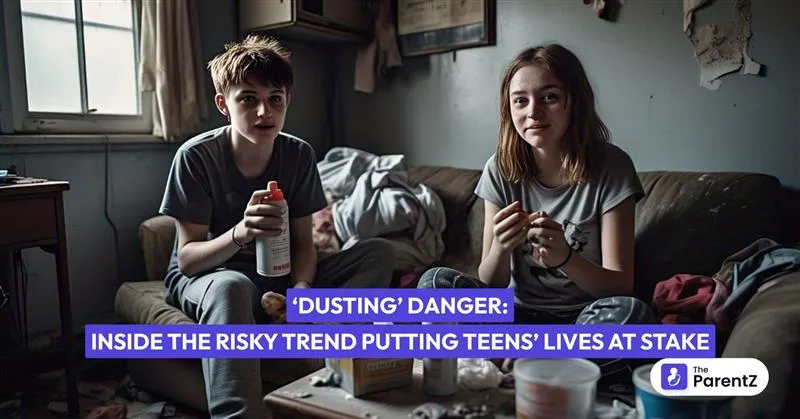There’s a dangerous trend flying under the radar in many schools and neighborhoods right now. It doesn’t come in pills. It doesn’t smell like smoke. You won’t find it in vape pens or bottles. It comes in a can that looks totally harmless: a can of keyboard cleaning spray.
This is what teens are now calling dusting. And it’s not just a phase. It’s serious, it’s risky and it can be deadly.
What Is Dusting?
Dusting is a form of inhalant abuse. It happens when someone inhales or "huffs" the chemical gases found in aerosol sprays; specifically, canned air used for cleaning electronics. These sprays contain chemicals like difluoroethane or tetrafluoroethane, which are refrigerants meant to blast dust out of keyboards and computer parts. They are not safe for breathing in any form.
But teens are using them to get high.
Some spray the aerosol directly into their mouth or nose. Others use a straw to breathe it in. The effect is quick. Within seconds, they feel a dizzy rush, a floating sensation, maybe even hallucinations or euphoria. The high is intense but fades fast and that’s exactly what makes it so dangerous.
To keep the feeling going, they must do it again. Then again. And again.
Why Are Teens Doing This?
Teens today are under a lot of pressure. School, social media, anxiety, peer expectations, body image, the need to feel something or escape something; all of it eventually adds up. Some teens say they start dusting out of curiosity. Others are trying to deal with emotional pain, trauma, or boredom. Some are just looking for something extreme to do.
The appeal is obvious to a young mind. It’s cheap. It’s easy to get. You don’t need to go to a dealer or hide it in a special container. You can buy a can at an office supply store, bring it home, and no one suspects a thing.
To them, it might feel like a quick thrill. But the truth is much darker.
What Dusting Does to the Body and Brain
Inhaling these chemicals can be fatal. We’re not talking about long-term risks alone. Even one hit can stop a heart. This is known as sudden sniffing death syndrome, and it can happen the very first time someone tries dusting.
The chemicals in these sprays displace oxygen in the lungs and brain. That means while a teen is chasing a high, their brain is literally being starved of oxygen. This can cause loss of consciousness, seizures, and even death. The heart can suddenly go into an abnormal rhythm and stop beating.
Other effects include:
- Headaches and nausea
- Dizziness and slurred speech
- Blackouts and memory loss
- Impaired coordination
- Hallucinations and paranoia
- Aggressive or confused behavior
Over time, repeated use can lead to permanent brain damage, liver and kidney problems, and long-term mental health issues like depression and anxiety.
And let’s not ignore the emotional toll. Many kids who get into dusting report feeling disconnected, ashamed, or numb in their everyday lives. The short high gives them a break but it also pulls them deeper into a cycle they can’t easily escape.
How It Turns into Addiction
Like many substances, dusting is addictive but not always in the way most people think. It’s not just a physical addiction. It’s often behavioral and psychological.
Teens start to rely on the high to feel normal. They get used to the escape. When things get hard, instead of reaching out or coping in healthy ways, they go back to the can. They begin hiding it. They lie about it. They isolate themselves. They chase a feeling they can never fully hold onto.
Before long, it’s no longer about feeling good. It’s about not feeling awful without it.
What Parents Need to Know
Dusting is not easy to spot. It’s not like alcohol or weed, where you smell something or find obvious signs. But there are red flags you can watch for.
Signs your teen may be dusting:
- Empty cans of keyboard cleaner around their room or in the trash
- Chemical smells on clothes, breath, or in their space
- Sudden mood swings or outbursts
- Unusual tiredness, confusion, or lack of focus
- Headaches or nosebleeds
- Loss of interest in things they used to enjoy
- Hiding their belongings or becoming secretive
- Drops in grades or skipping school
- Frequent light-headedness or unsteady movement
What You Can Do As a Parent
1. Talk to your kid: Start the conversation before you see signs. Talk calmly. Ask questions. Don’t lecture or accuse. The goal is to keep the door open, not slam it shut.
2. Educate them: Many teens genuinely don’t know how dangerous dusting is. They might think it’s harmless because it’s not a “real” drug. Show them the science. Let them know how it affects the body and brain.
3. Remove temptation: If you have canned air products in the house, keep them somewhere secure. Better yet, consider removing them altogether unless truly needed.
4. Look for emotional pain: Dusting is often a symptom, not the core problem. If your child is struggling emotionally, mentally, or socially, support them in finding real help whether that’s therapy, school support, or trusted adults they can talk to.
5. Be ready for hard conversations: If you find out your teen is dusting, stay calm. It may be shocking and heartbreaking, but anger alone won’t help. Focus on getting them help and showing that you’re on their side, even if you don’t approve of their choices.
6. Know when to get professional help: If your child is showing signs of addiction, don’t try to fix it all alone. Contact a mental health professional, addiction counselor, or youth support service. There are programs that specialize in helping teens with inhalant abuse.
In Worst Case Scenarios
If your teen passes out, is unresponsive, or shows signs of a medical emergency after using an inhalant, call emergency services immediately. Time matters. Do not wait to see if they wake up. The effects on the heart and brain can be instant.
After the emergency is over, follow up with a full health evaluation and a treatment plan. Inhalant abuse, even if it looks like a one-time event, should never be ignored.
Conclusion
Dusting is one of the most silent and deadly trends among teens today. It’s disguised as harmless. It’s cheap and easy to get. And it’s often overlooked until it’s too late.
But parents, teachers, and caregivers can make a difference. The key is awareness, early conversations, and compassion. Your teen might not know how dangerous this trend really is. They may be hurting or lost in a way they can’t explain. But they are not beyond help.
Stay present. Stay informed. And never be afraid to talk, even about the hard stuff. Because sometimes, just asking the right question can change (or save) a life.








Be the first one to comment on this story.